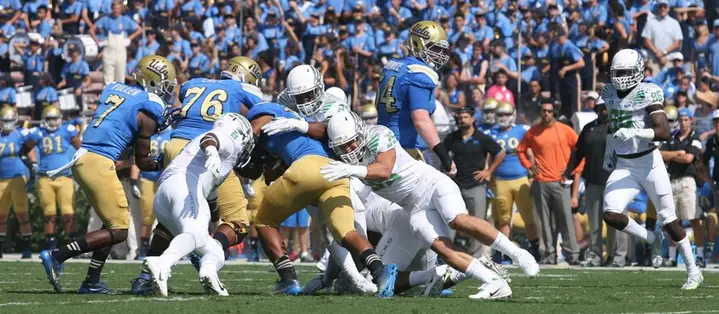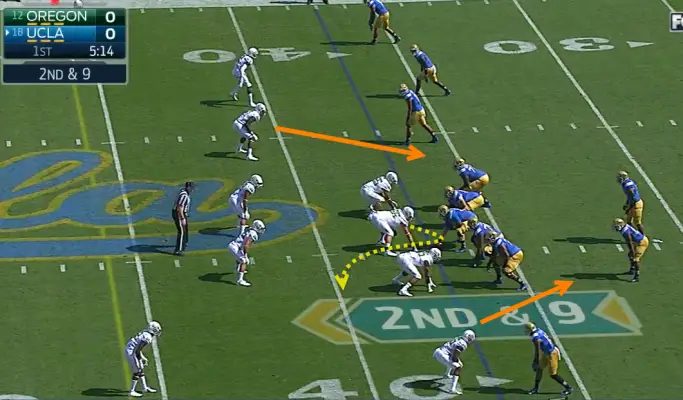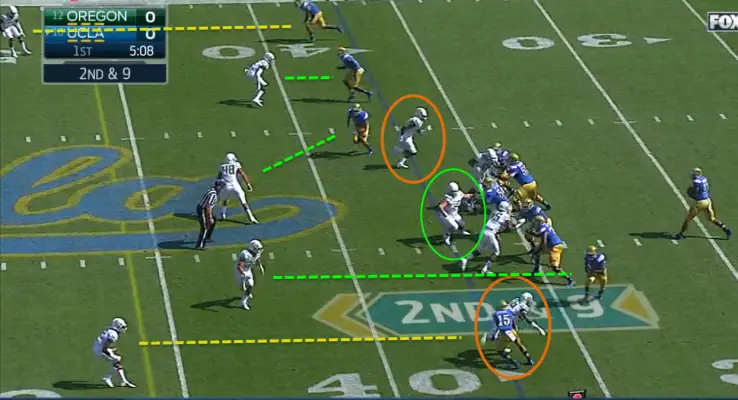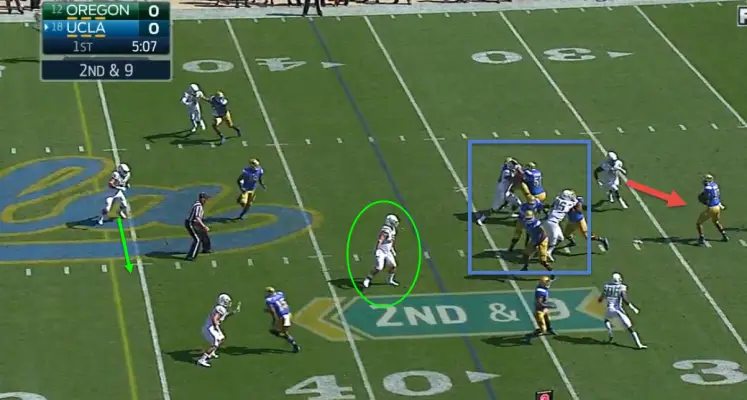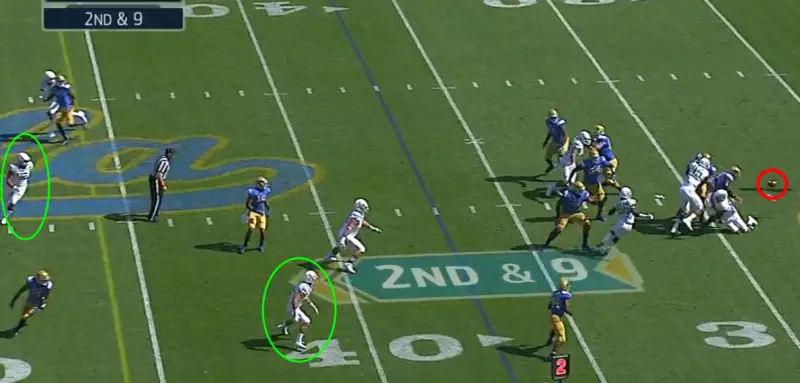Think about this for a moment: the Ducks went to the National Championship with a first year defensive coordinator, first year linebacker coach, and a second year defensive line coach. Despite this youth among the coaching ranks, and despite being underreported by national media sources, the Oregon defense excels at creating turnovers, which is clearly a point of emphasis by the defensive staff. Let’s examine how they do it.
The Ducks play a lot of zone coverage in the secondary, but are not limited to that, jumping into man coverage, mixed zone and man coverage, and bringing pressure from each one of these looks. It is fascinating to see how the Ducks disguise their man coverage and blitzes by lining up in ways that mimic multiple coverage schemes.
Below is an example from the UCLA game last October. In the first nine minutes of game time Oregon lined up on defense by showing a mix of at least three coverages on a single snap, and a couple hybrids of those three coverages.
Above is the pre-snap look for the play I want to focus on. It begins looking like a Cover 1 or 3 because of the single high safety. At the snap, five players rush, showing a blitz look. But it is actually not a blitz, due to a HUGE twist thrown in by nose tackle (NT) Alex Balducci.
This “blitz” (above) is by both outside linebackers (OLBs), as shown via the orange arrows. Balducci’s fake rush (see yellow dotted line) keeps the attention of the UCLA offensive line inward, giving time for one or both linebackers to clear the edge. Then he drops back to frustrate any late or delayed crossing route over the middle. Going from five to four rushers all of a sudden makes this blitz…not a blitz. Blitzes are, by definition, five or more rushers, as I learned from the Grizzled Ol’ Coach (thanks Mike!).
While the OLBs rush (orange ovals above), the corners, a safety, and inside linebackers (ILBs) are picking up the five receivers, as shown with the green and yellow dashed lines above. With the OLBs into their “blitzes,” the NT has reversed direction (green oval).
As seen above, the effect of this call is that five UCLA linemen are tied up with the two Duck defensive ends (see blue rectangle). Coverage is good on the receivers outside, and the crossing pattern by the slot receiver is taken away by the NT (green oval) and an ILB (green arrow). Meanwhile, pressure is coming off the edge, as Tony Washington closes fast on UCLA quarterback Brett Hundley (red arrow).
With opportunity knocking, Washington makes the hit (above) with help from T.J. Daniel, who shed a double team to reach Hundley. This pressure causes the ball to pop loose (see red circle above). Note how the corner in the upper left is still in man coverage with the wide receiver. Meanwhile, the two ILBs (green ovals) are occupying the middle and near side zones, keeping the slot receiver and running back in front of them.
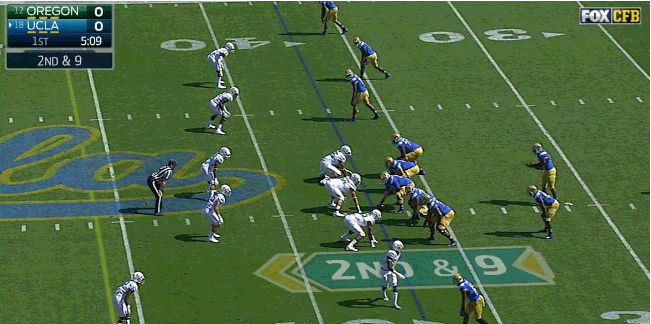
An opportunistic defense sets up the offense in prime field position.
So what is this scheme? Cover 1? Cover 3? Man-to-man? I can’t quite tell, and that’s a good thing, because opponents might not be able to tell either. As the video shows, the above play ended in a turnover, and ultimately led to Oregon’s first touchdown of the game. The Duck defense gets so little attention, but it deserves a lot of love for putting the sparking offense on a short field many times throughout the course of the season.
As many of you know, the Oregon defense often faces criticism that it can’t play with the bruisers. These critics are simply interpreting what they see, albeit incorrectly. The Ducks rely heavily on team speed to keep opposing offenses in front of them. They then execute unexpected or unconventional tactics at a high level to create negative plays at opportune times, giving their explosive offense extra possessions.
“Oh, how we love to learn about our beloved Ducks!”
Jay MacPherson
Oregon Football Analyst for CFF Network/FishDuck.com
Eugene, Oregon
Top Photo by David Pyles
I told my wife I might spin some yarn for FishDuck. She replied “You know nothing, Jay Mac.” She is probably correct, but since her name isn’t Ygritte, I’m jumping in. First off, you should know that I know almost nothing about football. Not the terminology, the techniques, the standards, the…wait for it…tradition. So I’m figuring at least I’ve got 1/4 of this covered from Duck perspective. Until two years ago at the age of 55, I played sports regularly. Much of it was Ultimate (that disc game, which is now officially recognized by the International Olympic Committee). So what? Well, in Ultimate, every player is a receiver, a cornerback/linebacker, and (to varying extents per play) a quarterback. The skills at getting open, at covering, at throwing (successfully) all apply to football. The object simply behaves differently while in flight. Oh, and there are the plays: getting people open, keeping opponents from getting open, etc. Thus, after playing a somewhat similar game for 33 years, and being a coach much of that time, I might know a little bit about player heart, techniques, and teamwork. I hope I can illuminate something new in Duck sports for you once in a while.

